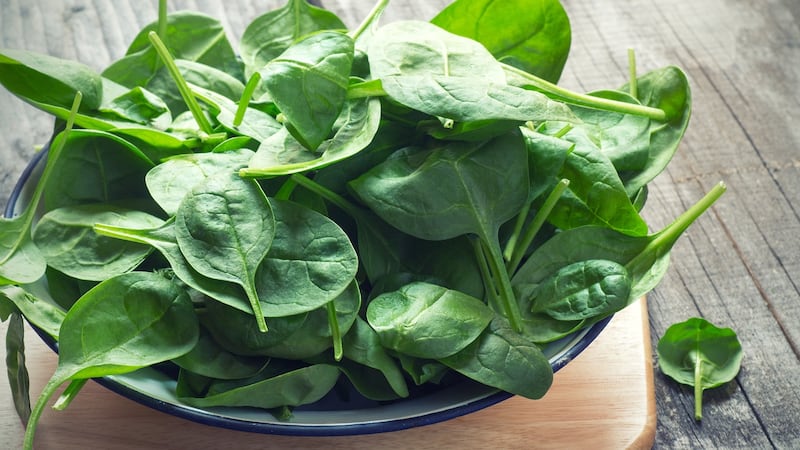Almost half of adult women and three-quarters of teenage girls aren’t getting enough iron from their food, according to the most recent dietary guidelines.
"Iron deficiency is one of the biggest nutritional deficiencies across the world and women need more iron than men because they lose it through menstruation, pregnancy and lactation," says Louise Reynolds, dietitian and communications officer with the Irish Nutrition and Dietetic Institute (INDI).
Iron is an essential mineral required to deliver oxygen to all cells of the body. And, while men need about 10 micrograms a day, menstruating women need about 14 micrograms a day. The iron needs of older women revert to those of men.
"Traditionally in Ireland, men are given larger portions of foods like red meat but it's menstruating and pregnant women who need more iron than men," says Reynolds. Men also tend to eat protein for lunch and dinner while many women opt for vegetable soups and salads at lunch time, missing out on iron from protein sources.
Anaemia
However, it's important to distinguish between anaemia – which is a medically defined low level of iron – and not getting the recommended daily allowance of iron which the Irish University Nutritional Alliance surveys record. The symptoms of anaemia are tiredness, irritability, headaches and a pale, washed-out facial complexion but it must be diagnosed by a general practitioner or nurse practitioner following a blood test. Only then are iron supplements prescribed.
"Women shouldn't take iron supplements unless a doctor has identified low iron levels following a blood test," says dietitian Sarah Keogh. This is important because low blood iron could also be linked to other conditions such as coeliac disease. "Then, following the course of supplements, it is advised to have another blood test to see if the iron levels have returned to normal," says Keogh.
In the past, pregnant women were prescribed iron supplements as a matter of course. However, now only those found to have low iron levels are recommended to take iron supplements during pregnancy. Better awareness of haemochromatosis, the genetic disorder which causes excess iron to be stored in the body’s organ, has also contributed to a more cautious approach to taking iron supplements.
Too much iron
Aside from haemochromatosis, symptoms of having too much iron in your body are constipation, vomiting and stomach pains. In fact, taking iron supplements can in itself also cause discomfort and pharmacists recommend they are taken on an empty stomach.
"It's best to take iron one hour before a meal or two hours after a meal. They are best absorbed when taken without food and with orange juice (because vitamin C helps the absorption of iron) but never with milk," says pharmacist Ann Marie Horan. Medicines such as tetracycline antibiotics and some thyroid and stomach medications also reduce the absorption of iron so they shouldn't be taken at the same time as iron supplements.
Diet
However, the easier way to avoid the symptoms of low iron levels is to ensure you have enough of it in your diet. Red meat, fish and poultry contain the most easily absorbed form of dietary iron known as Haem iron. Plant sources of iron are leafy green vegetables (for example, spinach and kale), wholegrains, dried pulses, fruit and seeds. However, this plant form of dietary iron (known as non-Haem) is more difficult to absorb. Non-haem iron is also sensitive to compounds found in tea, coffee, cocoa and red wine and the iron won’t be absorbed as well if iron-rich foods are eaten at the same time as these drinks.

Reynolds says one of the biggest concerns is low levels of iron among teenage girls who become vegetarian. “This is a particularly vulnerable group because growing and studying places extra demands on their bodies already and vegetarians have to be very careful to get high enough non-haem sources of iron as possible,” says Reynolds.
“We don’t expect people to add up their iron intake but including eggs in a vegetarian diet is a good way to ensure adequate iron intake,” she says. Fortified breakfast cereals, fortified milks and juices, dried fruit and seeds are other readily available sources of iron and other important minerals.
Iron-rich meal ideas
- Scrambled egg with mushrooms, grilled tomato and fruit juice
- Fortified breakfast cereal, berries and fruit juice
- Sardines with wholegrain toast and green salad
- Omelette with chopped peppers and mushrooms
- Spaghetti bolognese with grilled tomatoes and garlic ciabatta
- Spiced beef or pork stir-fried with noodles, babycorn and mangetout
Meal suggestions from the Irish Nutrition and Dietetics Institute website indi.ie which also includes fact sheets on nutritional requirements including iron.











